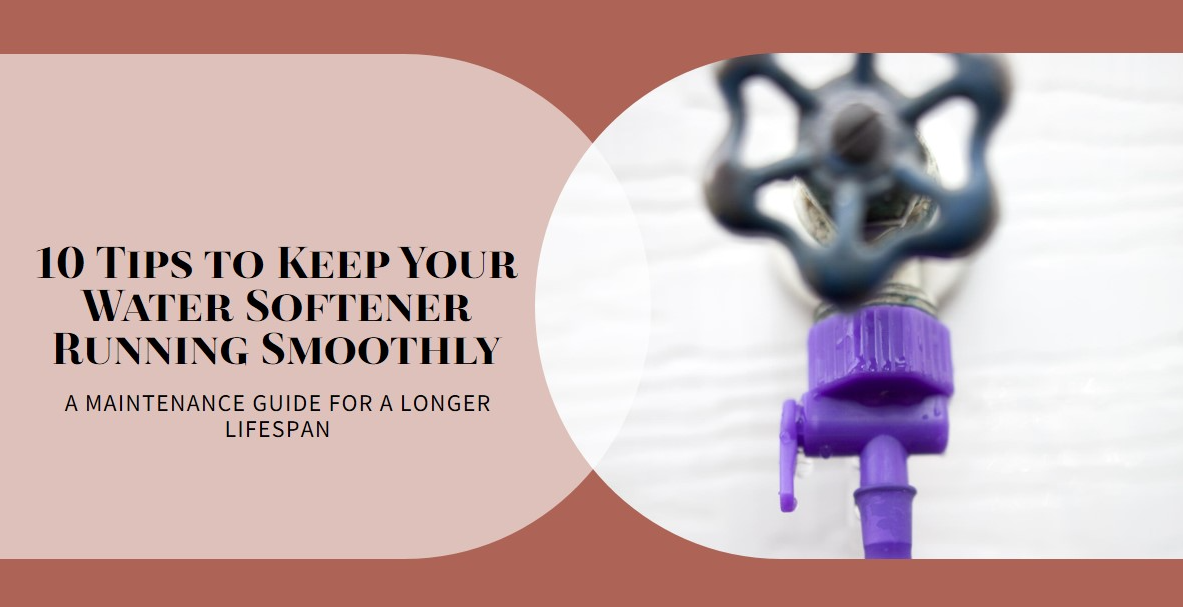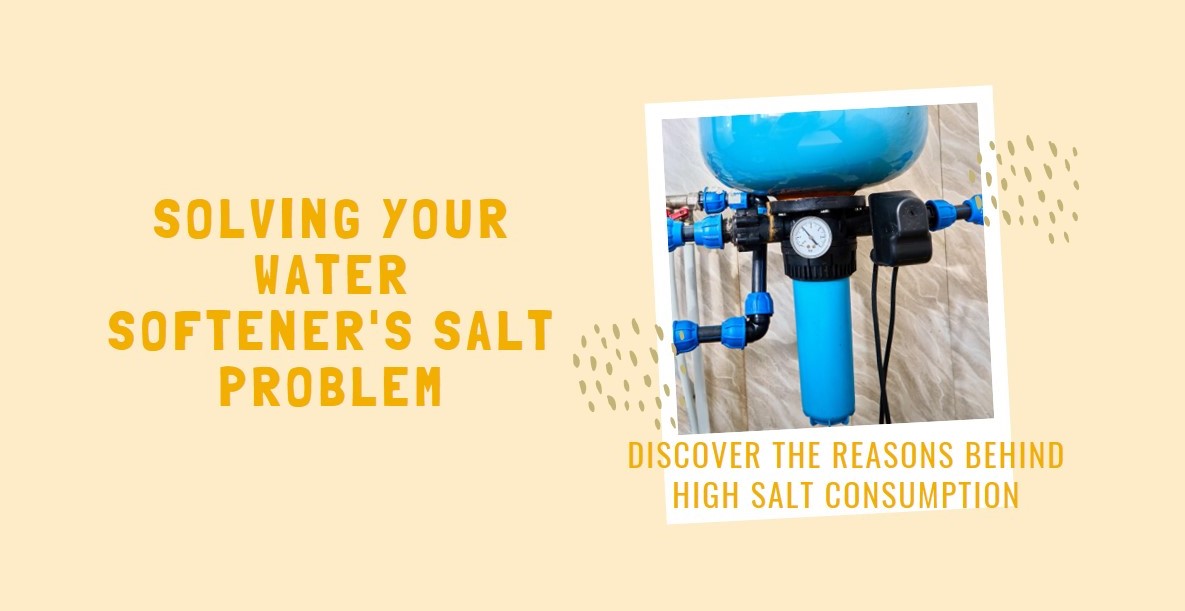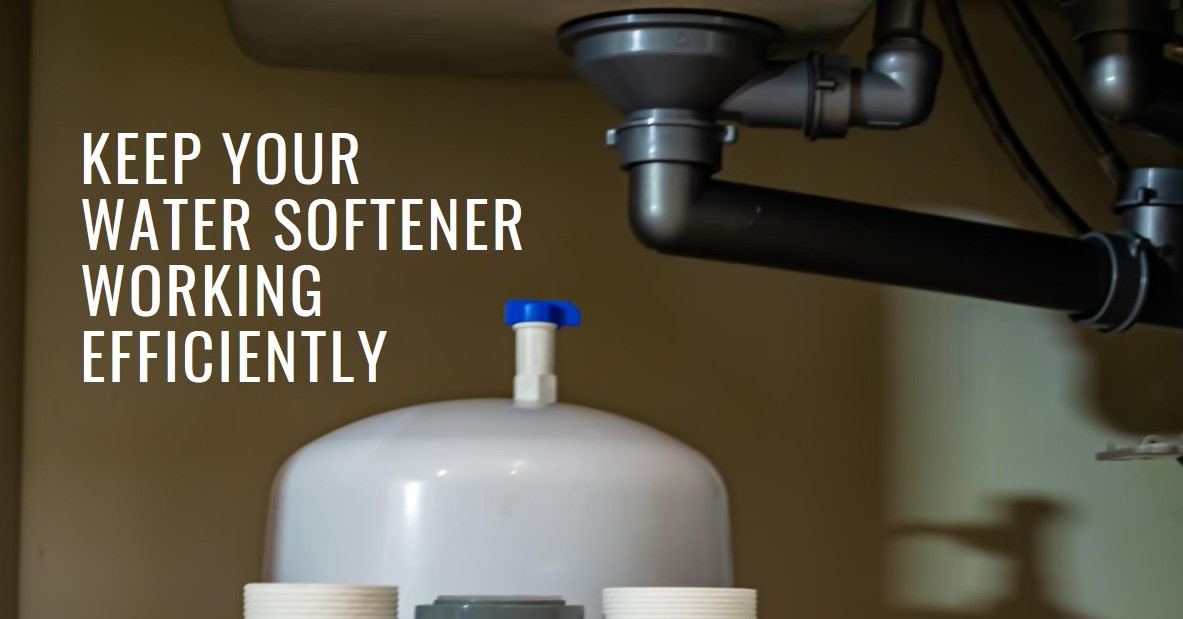Hard water can cause major problems in homes, from damaged appliances to ruined laundry. A water softener is an essential appliance for dealing with hard water, but like any appliance, its lifespan is limited. With proper care and maintenance, you can extend the life of your water softener significantly. This comprehensive guide will teach you how to keep your water softener running smoothly for years to come.
What is a Water Softener and How Does it Work?
A water softener is a whole-house filtration system that removes minerals like calcium and magnesium from hard water. The most common type is an ion exchange water softener.
It works by filtering the water through a tank filled with small resin beads. The beads have a negative charge, so they attract and bind to the positively charged calcium and magnesium ions. This ion exchange process substitutes sodium ions for the harder mineral ions. The softener later flushes the sodium and minerals out through a regeneration process.
The benefits of softened water include:
- Fewer mineral deposits and scale buildup on fixtures and appliances. This helps them last longer.
- Cleaner laundry and dishes. Hard water reduces the cleaning power of soap.
- Smoother skin and hair after bathing and washing.
- Longer lifespan of water heater and pipes. Soft water is less damaging.
Tips to Extend the Lifespan of Your Water Softener
1. Add a Pre-Filter
Installing a sediment pre-filter ahead of the softener protects it from dirt and particles. This filter removes contaminants before they reach the resin, keeping it cleaner. Less buildup in the tank means the softener can operate more efficiently for longer.
Choose a 5 micron or smaller sediment filter to trap particles. Install it on the main water supply line where it enters the house. Follow the manufacturer’s instructions to size and install the filter properly.
Check and replace the pre-filter cartridge per the manufacturer’s recommended schedule. Doing this simple maintenance task helps safeguard the lifespan of the softener.
2. Use the Correct Salt
Replenishing the salt regularly is crucial for softener regeneration. Salt pellets formulated for softeners are compressed for slow dissolution. The softener is programmed to use a certain amount for regeneration based on the salt type.
Using rock salt or salt with high impurities can cause problems:
- Clogged parts leading to malfunction
- Poor brine solution for regeneration
- Build up in the resin tank shortening its lifespan
Stick to high purity softening salts to avoid these issues. Some formulas also have anti-bridging additives to prevent clogs and help it dissolve evenly. This ensures proper regeneration cycles.
3. Maintain Proper Salt Levels
Check the salt level monthly and top it off as needed. Running low on salt can allow hard water to bypass into your home. It also leads to incomplete regeneration cycles that fail to fully refresh the resin beads.
Ideally, aim to keep the brine tank at least half full of salt at all times. The salt level will reduce after each regeneration. How frequently it needs topping off depends on your water hardness and softener settings.
Most models have a salt level indicator that shows when it’s time to add more. Pay attention to these alerts.
4. Use Salt Designed for Softener Regeneration
Do not put standard table salt, rock salt, or salt pellets not formulated for softeners into the brine tank. Table and rock salt contain high levels of impurities that can damage softener parts. They also dissolve too quickly, leaving the brine tank empty in between refills.
The right softening salts dissolve slowly and contain over 99% sodium chloride purity. They are compressed into pellets specifically sized for softener systems. This helps ensure proper saturation of the brine solution for regeneration.
5. Flush and Sanitize Regularly
Over time, sediment, salt residue, and bacteria can build up in a water softener. Performing an occasional flush helps clean the system.
To flush a softener:
- Set the softener to “bypass” mode.
- Attach a garden hose to the drain outlet.
- Run the softener through a manual regeneration cycle. This flushes water through the resin beads and into the drain hose.
- Clean brine tank with 2 cups of bleach. Scrub away any salt bridging or residue buildup.
- Rinse thoroughly.
Flush every 3-4 months or as needed to optimize softener function. Sanitizing the brine tank annually helps prevent bacteria growth.
6. Inspect and Replace Parts as Needed
As parts wear out or fail, replace them promptly to avoid bigger issues. Some commonly replaced parts include:
- Resin beads – Ion exchange beads last 5-10 years typically. Gradual resin fouling will lead to hardness leakage.
- Seals & spacers – Damaged seals around the piston and main tank can cause salt and water leaks.
- Valves – Malfunctioning valves affect the regeneration process. Sticking valves lead to excess water use.
- Filters – Replace any pre-filters and brine tank screens per the manufacturer’s schedule.
Inspect all softener parts during salt refills and service. Look for leaks, unusual noises, errors codes, and changes in performance. Preventative part replacement extends the lifespan well beyond the typical 10-15 years.
7. Maintain Adequate Water Pressure
Operating a softener at very high or very low water pressures can damage parts and reduce effectiveness. Ensure your home’s water pressure stays in the normal range of 30-80 PSI.
Check the pressure at least annually. Install a pressure reducer if needed to lower high pressure. For low pressure, add a booster pump.
This prevents strain on softener components. The resin tank, valving, and seals last longer when under proper pressure. Stable pressure also allows proper brine draw and rinse cycles.
8. Allow Proper Flow Rates
Flow rate refers to the volume of water passing through the softener. Both high and low flow rates can harm the system.
High flow above the softener’s service flow rating strains the resin bed. The rapid water flow can flatten resin beads, which then lose effectiveness faster.
Low flow below the backwash flow rating leads to incomplete cleaning of beads during regeneration. Slow rinses leave more hardness on the resin to build up over time.
Consult your specific model’s specs for the right service flow and backwash flow rates. Use these to properly size your softener and avoid flow-related damage.
9. Limit Water Bypass
Some homes have a hardness bypass valve that mixes hard and soft water to achieve an intermediate hardness level. Avoid using this valve regularly. Send all incoming water through the softener whenever possible.
Constant bypassing accelerates wear on the softener parts. The resin works harder during regeneration to remove mineral buildup from periods of bypass. Frequent bypassing also shortens the lifespan of the resin beads themselves.
Bypass only during infrequent high water demand situations like filling a pool or watering the lawn. Otherwise keep the valve fully closed.
10. Invest in a Water Softener from a Reputable Brand
Higher quality softeners made by leading manufacturers will last longer overall. They tend to use better materials and components that withstand years of use. Established brands also often have better warranties and customer support.
Do some research before purchasing to find water softener brands with a reputation for reliability and durability. While you’ll pay more upfront, a well-made system saves you money in the long run through fewer repairs and part replacements. It also provides an extended lifespan.
Water Softener Maintenance Guide
Proper maintenance is crucial for maximizing the lifespan of your water softener. Follow this schedule to keep it operating efficiently.
Monthly
- Check salt level
- Add salt as needed
- Inspect brine tank for bridging or residue
- Test water hardness
Every 3-4 Months
- Flush softener system
- Clean brine tank
- Check for leaks, noises and errors
- Inspect parts for wear and damage
Annually
- Deep clean brine tank
- Sanitize with bleach
- Lubricate o-rings
- Cycle test the system
Every 3 Years
- Replace resin beads
- Replace piston and seals
- Inspect control valve
Every 10 Years
- Replace brine valve
- Replace resin tank
- Replace control valve head
- Full system inspection
Following this timeline helps prevent issues through proactive part replacement and cleaning. Be sure to also check your specific softener’s owner’s manual for additional manufacturer recommended maintenance.
Signs It’s Time to Replace Your Water Softener
While regular upkeep extends the lifespan, water softeners do eventually wear out. Here are signs it may be time to replace your existing softener:
- Age of 10-15 years – The average lifespan of a water softener is 10-15 years. Units exceeding this age are nearing the end.
- Lack of softness – If you notice skin/hair feeling like before, stiff laundry, and spotty dishes, the softener is failing to remove hardness.
- Equipment damage – Appliance damage from scale buildup indicates the softener is no longer protecting them.
- High salt use – Needing to add salt much more frequently can signify a problem with the system.
- Electricity spikes – Unexplained high electrical bills can point to an inefficient or malfunctioning softener.
- Error codes – Persistent or recurring error codes often mean it’s time to replace a faulty system.
- Water leaks – Leaking from the tank, valve, or fittings can indicate age and wear. Water on the floor around the softener is never normal.
- Noisy operation – Grinding, knocking, whining noises signal a malfunction needing replacement.
- New technology – Upgrading to a more efficient Demand Initiated Regeneration system can be worthwhile.
Replacing a very old or damaged softener saves money over constantly fixing and maintaining a failing unit. A new efficient model also provides benefits like water savings and ease of use.
FAQs About Maximizing Softener Lifespan
What is the average lifespan of a water softener?
With proper maintenance, a water softener will typically last 10-15 years. High quality systems made by leading brands can sometimes last up to 20 years.
Does salt quality affect water softener lifespan?
Yes, using very pure softening salts without impurities allows for optimal softener function over a longer period. Rock salt or impure pellets can damage softener parts over time.
Should I buy the longest water softener warranty?
Not necessarily. While a longer warranty does suggest faith in lifespan, a standard 5-10 year warranty is usually fine for quality softeners. Just be sure the company offers good support.
How often should you sanitize a water softener?
Sanitizing the brine tank once a year helps kill bacteria and prevent odors. Cleaning agents like bleach or brine tank cleaners can be used.
Will a whole house water filter increase softener lifespan?
Yes, pre-filters significantly extend the lifespan by keeping sediment and particles from reaching and fouling the softener resin.
How can you get the most life out of water softener resin?
Regular flushing, proper salt levels, avoiding bypass, and maintaining adequate water pressure all help resin last longer. Timely replacement at 5-10 years is also key.
At what point does fixing an old softener stop being worthwhile?
Once repairs start becoming frequent and significant, like valve replacements or tank rebuilds, replacement tends to be the better investment. Each situation differs though.
Is it better to repair or replace an old water softener?
If yours is over 10 years old and needing major repairs, replacement is typically the better option. Newer systems last longer between repairs and are more water and energy efficient.
Ensure Years of Protection with Proper Water Softener Care
Hard water wreaks havoc in homes, damaging appliances, plumbing, and more. A water softener prevents these headaches through essential whole home water filtration. Like any complex appliance, water softeners require maintenance and care for longevity.
By properly cleaning, replacing worn parts, using quality salt, and more, you can keep your water softener running smoothly for 10-15 years or longer. This saves you the cost and hassle of frequent repairs or early replacement. Be diligent with upkeep and your water softener will continue providing the benefits of soft water for years to come.





